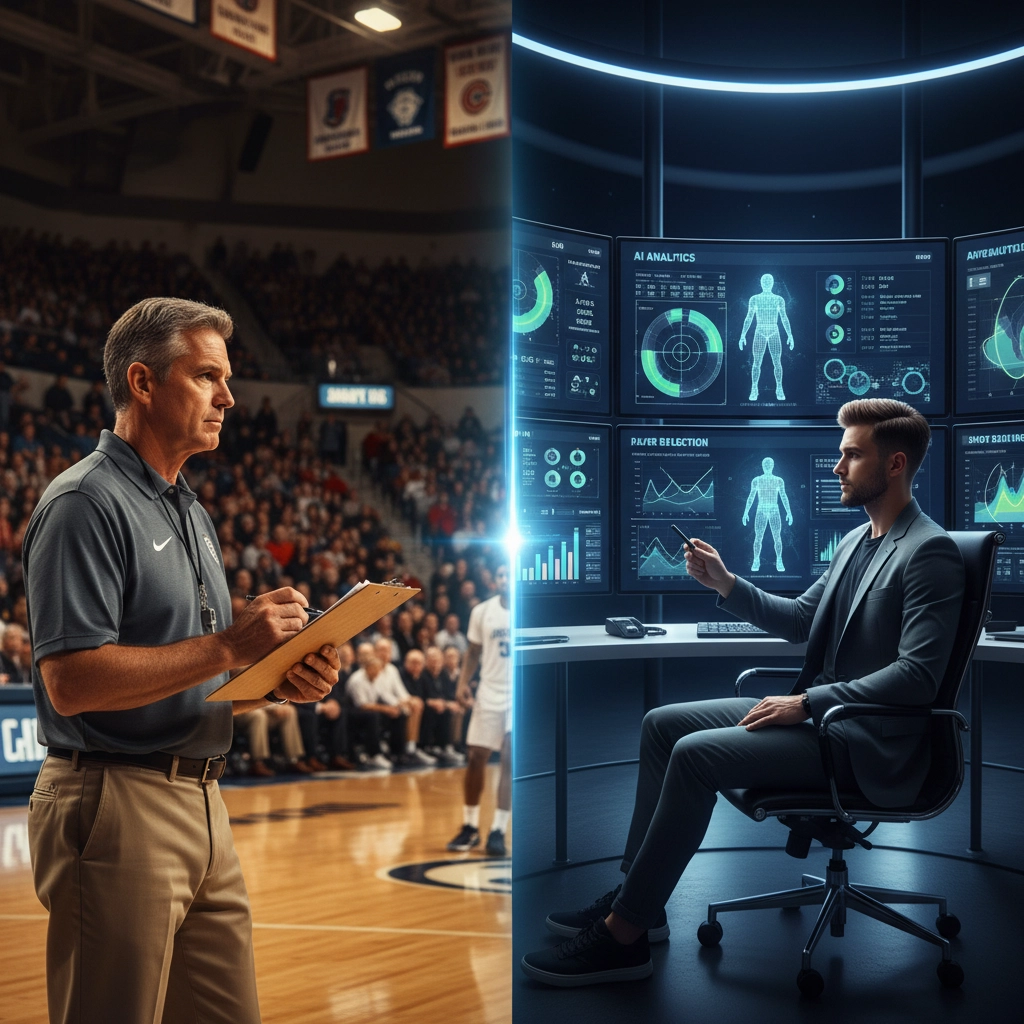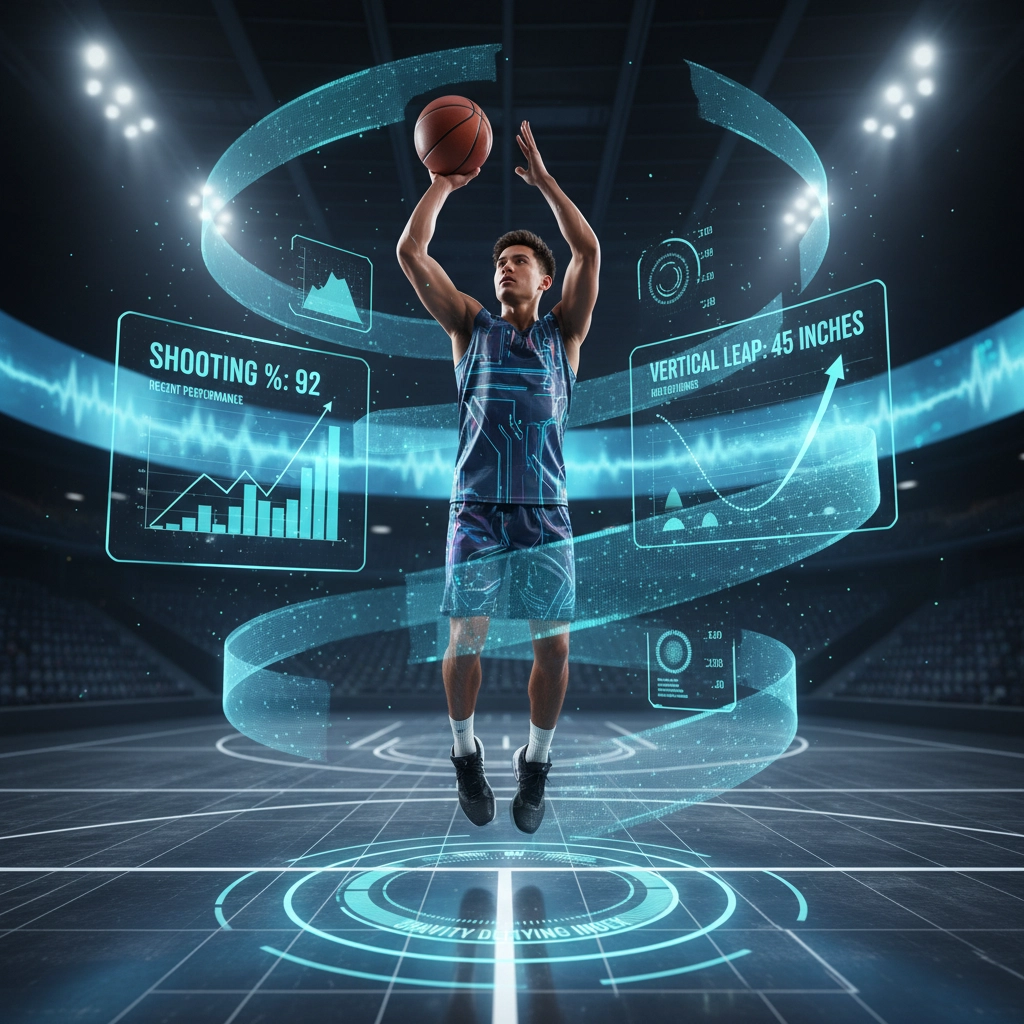While athletes and families still think coaches are watching game footage and attending showcases to find talent, the reality is far different. AI-powered recruiting tools have created a hidden evaluation layer that's fundamentally changing how college programs identify, assess, and recruit student-athletes.
Here's what's really happening behind the scenes – and what coaches don't want you to know about it.
The Algorithmic Gate That Eliminates You Before Coaches Watch
College coaches aren't starting with your highlight reel anymore. They're starting with your numbers, and AI systems are filtering out athletes before human eyes ever see them play.
Coaches now use data-driven algorithms to eliminate prospects before reviewing any video content. These systems analyze player metrics, academic performance, and even social media activity to create initial prospect rankings. If your data doesn't meet their algorithmic thresholds, you may never get a second look, regardless of how talented you appear on film.
This represents a massive shift from traditional recruiting methods. Where coaches once relied on regional scouts and personal networks, they now depend on AI systems that can process thousands of athlete profiles in minutes. The harsh reality? With over 450,000 NCAA student-athletes and limited scholarship spots, AI helps coaches filter through what they consider "noise."

The Metrics That Override Raw Talent
Coaches now prioritize hard data over subjective talent evaluation, and specific metrics carry more weight than highlight-reel plays. Understanding which numbers matter for your sport and position has become crucial for recruitment success.
For baseball players, exit velocity, spin rate, and launch angle data often determine initial interest levels. Football players are evaluated on 40-yard dash times, vertical jump measurements, and position-specific metrics. Basketball players face scrutiny over shooting percentages from specific court zones, defensive rebounding rates, and assist-to-turnover ratios.
The secret coaches don't advertise? They often have minimum metric thresholds that automatically disqualify prospects. A baseball player might need a minimum 85 mph exit velocity to even be considered, while a basketball guard might need to demonstrate a 35% three-point percentage from game footage.
AI-driven analytics break down every aspect of athletic performance into measurable components. This means improving the right statistical categories can be more valuable than general skill development – something most training programs don't emphasize.
Virtual Scouting Has Replaced Live Evaluation
The days of coaches traveling extensively to see prospects in person are largely over. Instead of attending games and tournaments, many college coaches now rely entirely on AI-generated scouting reports and virtual evaluation tools.
These AI systems provide detailed breakdowns that include swing mechanics analysis for hitters, pitching efficiency metrics and arm stress indicators, fielding footwork and reaction time assessments, and comparative analysis against current college athletes or professional prospects.
AI-powered video analysis tools enable scouts to assess athletes remotely, dramatically expanding the pool of potential recruits while reducing evaluation costs. Some software can even predict how a player's skills might translate to the college level by comparing movement patterns and performance metrics to successful athletes with similar profiles.
The uncomfortable truth for athletes banking on showcase events? Many coaches are making initial recruiting decisions based on uploaded video content processed through AI analysis tools, not live game observation.

The Performance Gap: AI Users vs. Traditional Approaches
The data reveals a stark difference in recruitment outcomes between athletes leveraging AI tools and those using traditional methods. Athletes utilizing AI-driven recruiting platforms are getting noticed faster, receiving offers earlier, and signing scholarships more consistently.
A documented case study shows this disparity clearly. Traditional recruitment methods – including $4,500 spent on exposure camps, professional highlight reels, and mass email campaigns – produced zero responses from college coaches. However, switching to an AI-powered recruiting approach generated three official college visits and multiple scholarship offers within four months.
The AI system optimized highlight footage to showcase specific plays that coaches actually valued, sent personalized outreach emails to programs that fit the athlete's statistical profile and academic credentials, and tracked which coaches engaged with the content to identify the most interested prospects.
The reality is that AI systems can identify which coaches are actively watching your content, allowing for strategic follow-up that traditional methods can't provide.
Hidden Predictive Analytics Shape Recruiting Decisions
Beyond current performance evaluation, AI systems now incorporate predictive modeling that forecasts future success and injury risk. Machine learning algorithms assess physical stress patterns, movement mechanics, and performance trends to estimate injury probability and career longevity.
College programs also use comparative analytics that cross-reference current prospects with historical data from similar athletes. These systems can predict growth trajectories, position changes, and even academic success probability based on thousands of data points.
This predictive capability allows college programs to secure commitments from athletes before competing schools recognize their potential. Coaches can identify undervalued prospects whose metrics suggest future stardom, offering scholarships to athletes who might become highly sought-after recruits within a year or two.
The recruitment process has transformed from subjective evaluation into data-driven science, with more hidden talent being discovered, fewer recruitment mistakes being made, and more efficient team-building strategies being implemented.

The Platform Revolution Behind the Scenes
Specific AI platforms have become essential tools in college recruiting operations, though coaches rarely discuss their reliance on these systems publicly. Video analysis platforms like Veo, Trace iD, and Spiideo enable comprehensive remote scouting capabilities, while training optimization tools like TrainAI and Athos provide personalized development programs that coaches use to evaluate coachability.
Specialized scouting databases like Sportlogiq for hockey and soccer, and Wyscout for comprehensive soccer analysis, have become standard resources for college programs. These platforms provide detailed performance analytics, injury tracking, and prospect comparison tools that inform recruiting decisions.
The reality coaches don't want to admit is that AI-powered scouting has become so prevalent that programs without these tools are at a significant competitive disadvantage in both recruiting and player development.
What This Means for Your Recruiting Strategy
Understanding how AI influences college recruiting changes everything about your approach to getting noticed. Instead of focusing solely on highlight reels and showcase events, you need to optimize your digital presence for AI evaluation systems.
This means ensuring your academic and athletic metrics are prominently displayed in easily accessible formats, creating content that AI systems can effectively analyze and process, and understanding which platforms college coaches in your sport actually use for prospect evaluation.
The athletes who succeed in this new landscape aren't necessarily the most talented – they're the ones who understand how to leverage AI-powered recruiting tools effectively. They present their information in ways that AI systems can process and rank favorably, while their competitors remain invisible to algorithmic filtering systems.
The recruiting game has changed permanently. The question isn't whether you'll adapt to AI-driven recruiting – it's whether you'll do it before your competition figures it out.
At Recruit My Game, we've built our platform specifically to help student-athletes navigate this new AI-powered recruiting landscape. Our system ensures your profile is optimized for the algorithms that coaches actually use, giving you the visibility advantage you need in today's competitive market.


